While travelling around Europe with my dog during 2017 and 2018, I read numerous reports about how expensive it would be to fly a dog to Australia, something we were planning to eventually do when we returned home in late 2018.
The dogs I read about were various sizes, plus were flying from different parts of Europe, or some were flying from the US. However, what all stories had in common was how expensive it was, at least going through a pet transport company.
So as I started to make plans to head back to Australia, I thought to myself, why don’t I organise my dog’s transport back to Australia by myself, without using a pet transport company? After all, we were becoming pros at travelling around the world with our dog.
Here’s what that process entailed and my experience bring my dog to Australia in late 2018, including the cost of bringing a dog to Australia. Be warned, this is a long post – so I’ve provided some links for you to jump to each section.
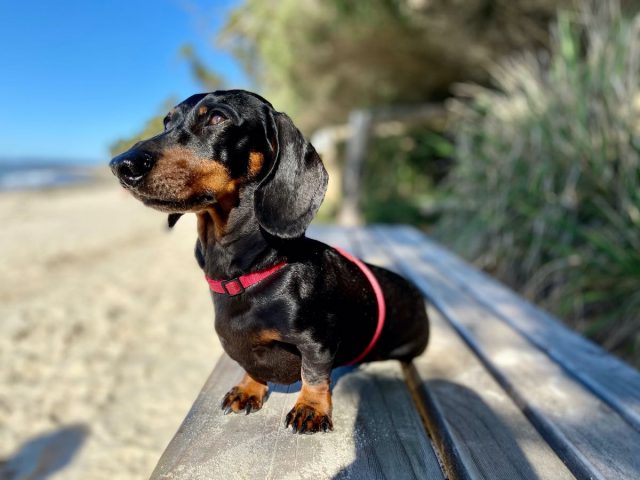
Choosing an Export Country
The first step you should do when planning on bringing pets to Australia is to look at the clear instructions provided online, a rather long and scary looking list. But my next step was something that wasn’t even on this list: it was deciding from which country we would fly back to Australia with our dog.
All the import process preparations need to take place in a single approved country (unless we got permission from the authorities in the export country, as noted in the documentation). But we were travelling around Europe, and not usually spending that long in any one country.
At least we didn’t have to worry about importing a dog from an unapproved country, something that it is no longer possible to do. All dogs being imported to Australia need to have not been in an unapproved country in the last 180 days, something that didn’t apply to us.

Another related factor was the choice of airline. Many airlines stipulate that pets travelling to and from Australia must be booked with an animal transport company.
However, I knew that Qantas was okay with pets being booked directly, as long as it was a direct flight or flights with a single code. Travelling from Europe to Melbourne (where the only quarantine facility is located in Australia, and where pets must fly to), the only option was QF10, from London to Melbourne.
(From about 2020 to 2022, Qantas stopping allowing direct bookings for pets. I have heard multiple reports that this is again available, but it’s best to speak directly to Qantas Freight to confirm the latest details.)
However, if we firstly headed to the USA (an easy destination to travel to with a dog), we could also take advantage of direct flights from San Francisco or Los Angeles to Melbourne. The USA was on my wishlist of destinations to visit, so we decided to head home via the US. There was also the advantage that it was an English-speaking country, so we wouldn’t have any language difficulties.
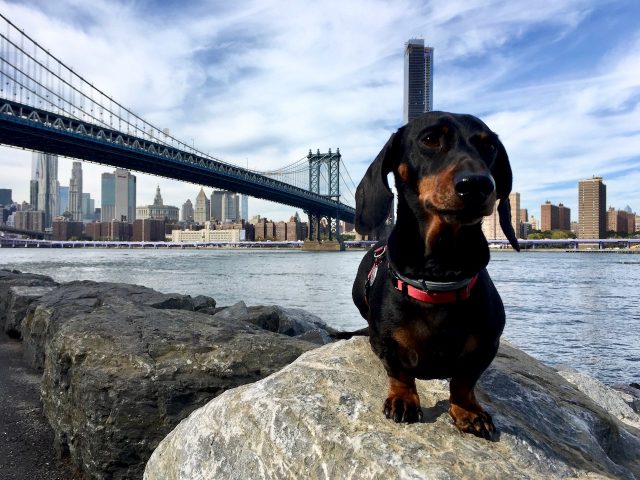
Steps to Prepare My Dog for Export to Australia
If you’re starting from scratch, the preparations for taking a dog to Australia can take over seven months for pet owners, depending on the country you are exporting your dog from.
However, because our dog, Schnitzel, was already vaccinated for rabies and had a rabies titre test performed before leaving Australia (which was still valid), our time needed to prepare our dog for export was greatly reduced, although it was still almost as complicated.
1. Selecting a Vet
Once we had decided to travel via the USA to export Schnitzel back to Australia, our first step was to select a government-approved vet in the USA (also known as a USDA accredited veterinarian). I asked online in an expat group and received a recommendation for Beverly Robertson Veterinary Clinic in Los Angeles. I also checked where they were located (given the size of the city) and their website.
I initially emailed Beverly Robertson with a few questions I had, and received prompt and informative replies. Later on I emailed them to make appointments for Schnitzel’s required vet visits.
As I wasn’t yet in the US, I managed to do this entirely through email, and I found the staff at the vet clinic to be familiar with the steps required for Australia, which was quite reassuring. Better for someone else to double check my date calculations in advance rather than realise an error later!
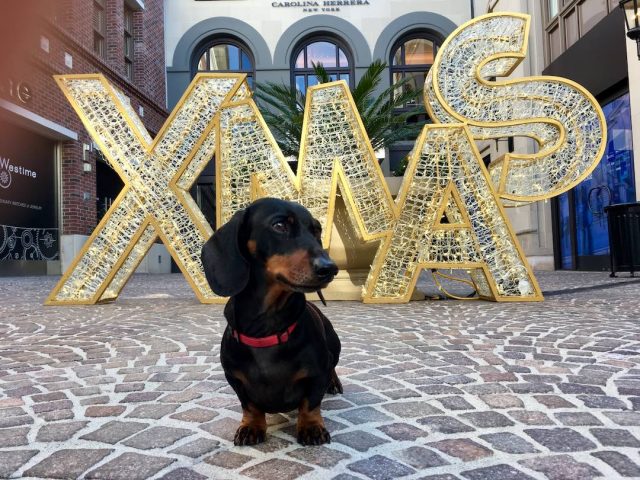
I actually should have started planning his appointments earlier, though, as I discovered that the test results took longer than I had expected to receive back in the US. This brought forward when I needed to schedule his first appointment, though luckily I could still fit the appointments around the travel plans we had started to make.
I recommend contacting your selected vet well in advance to check over timelines, before making any further plans.
2. Rabies Vaccination & Rabies Titre Test
Usually the first major step required to prepare your dog to travel to Australia is to vaccinate them against rabies and have a rabies titration test performed. Luckily, as I mentioned above, we did this before leaving Australia. Plus less than 2 years had passed. (Previously, the rabies titer test result was only valid for 2 years for the purpose of importing a pet to Australia, although this has now been reduced to one year.)
The additional advantage of having the titre test done before leaving Australia (at the Australian Animal Health Laboratory), was that we didn’t require an RNATT declaration to apply for an import permit, as mentioned on this page with tips for Australians taking their pets overseas and then returning.
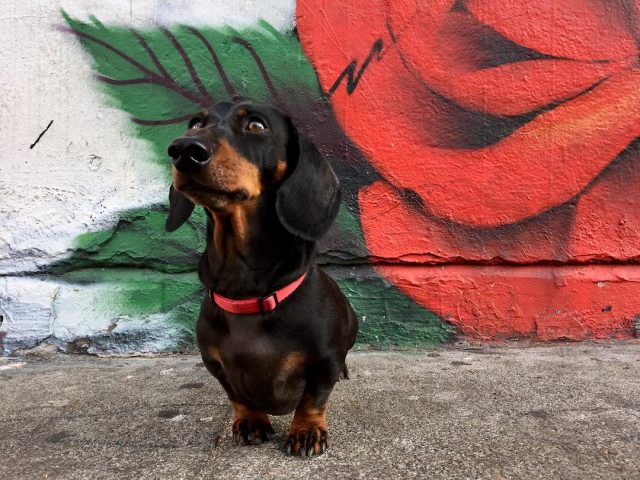
3. Applying for an Import Permit
The next step was to apply for an import permit, on the Australian Biosecurity Import Conditions website, which needed to be done at least 42 days in advance. The website is quite complicated, as it covers all types of imports, but once I figured it out where to get started, it was a fairly simple form.
The import permit is quite expensive – $480 AUD just for a permit, our first cost for returning our dog to Australia. (It has now increased to $566 AUD, as of August 2023.) We applied for the permit four months before flying back to Australia. It was then valid for one year.
The only hiccup I ran into during this step is that the export contact information had to have a US address, so I couldn’t use my Australian address I used elsewhere on the form. As we didn’t yet have a US address (even a hotel), I asked a friend in the US if I could use their address.
The same issue would probably apply if you tried to list a US (or other foreign) address in the import details section – you probably need to use your future Australian address or another Australian address. We never received any letters at the address we supplied – it was just a paperwork requirement.
4. Booking Quarantine
The next step was booking quarantine, at the Post Entry Biosecurity System website. Click on New Reservation on this page. I’ve seen recommendations to not use the site on a mobile phone – use a larger screen instead.
The quarantine reservation was also quite easy to do, although I had to follow up to get my reservation finally approved, a month after I initially applied. Apparently this was because I made the reservation so far in advance (3 1/2 months out), although I was just following the order of steps on the check-list!
(As of 2023, I’ve heard reports of spots in quarantine being booked out for months in advance, possibly due to the introduction of 30-day stays in quarantine for some pets. Get your valid import permit and make a quarantine booking well in advance.)
The first time I called up because my reservation hadn’t yet been approved, I was told that reservations were reviewed in order of quarantine date, despite a 10-day approval period being mentioned on the site. After a couple more weeks I sent a follow-up email, and Schnitzel’s quarantine reservation was finally approved.
In particular, I wanted to make sure it was definitely approved, as I knew that our booking was for a busy time of the year, early December. Be warned that the quarantine facility doesn’t usually accept new arrivals during the second half of December – check the dates each year.
5. Booking Flights
About the same time as booking Schnitzel’s quarantine, I also initially contacted Qantas Freight to get a quote for his flight from Los Angeles to Melbourne. This is the full page with details of their service for shipping animals internationally.
I sent an email to the email address ([email protected]) provided on the form for Qantas international pet transport originating in Australia. My email was then forwarded on to the relevant overseas office (Qantas Freight in LA).
I quickly received a quote back (well, I actually received two slightly different quotes from people in the same office). However, I was also advised I couldn’t actually book until a couple of weeks before the flight.
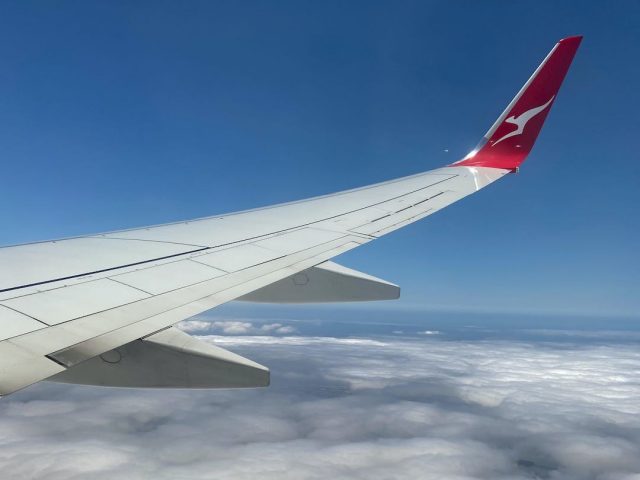
Unlike with human airline tickets, flying an animal via freight has a set price (based on either weight or crate dimensions, whichever is more expensive), rather than a fluctuating ticket price.
Note that it’s not possible to fly with your dog in the cabin to Australia, unless you are chartering a private jet, whether individually or as part of a group.
6. Visiting the Vet
During the two months before exporting your pet to Australia, expect to make at least three vet visits to perform all the steps required, perhaps more depending on your requirements.
Schnitzel’s first vet visit occurred in New York City (rather than in Los Angeles as planned), due to the duration it would take to later get test results. This visit occurred 6 1/2 weeks (47 days) before we flew to Australia. During this vet visit the following occurred:
- 1st dose of canine influenza vaccine (an extra step currently required to export dogs from the USA to Australia)
- 1st external parasite treatment
We provided the details of our NYC vet to our LA vet, who then requested details of the treatment so they had a copy for when the health certificate was later being filled out.
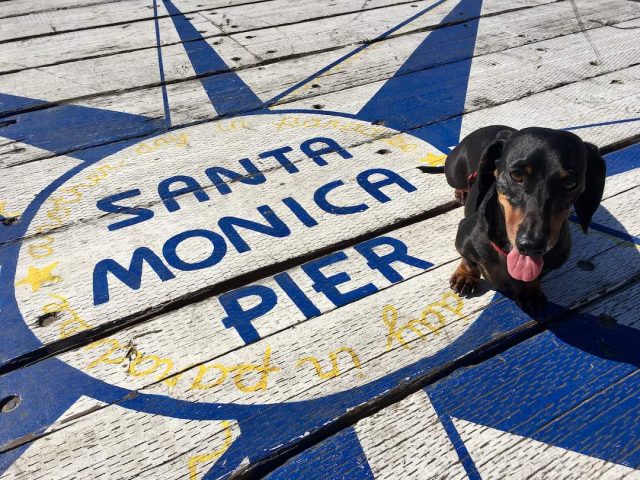
Our second vet visit (in LA) occurred 24 days later, 23 days before we flew to Australia. During this vet visit the following occurred:
- 2nd dose of canine influenza vaccine
- 2nd external parasite treatment (as each treatment was only valid for 31 days, and it still needed to be valid until the date of export)
- Blood sample for testing for leishmaniais, leptospira and ehrlichia (our vet then received these results for the blood tests 2 1/2 weeks later, just before our final visit)
- 1st internal parasite treatment
My main concern was about the blood test for leishmaniais. This disease which is spread by sand-flies exists in southern Europe. And immediately before travelling to the US we had spent six weeks in Greece, the country with the highest incidence.
We took multiple preventative steps, so it was unlikely our dog would have caught it, but I was very relieved for our vet to receive the test results, with the all clear for each disease.
Our third and final vet visit occurred just 2 1/2 days before our evening flight. It needed to be within 5 days of our departure (although ideally not a full 5 days before, in case your flight is delayed by a day). During this vet visit the following occurred:
- 2nd internal parasite treatment
- Clinical exam
- Health certificate completed covering all vet visits, along with the lab test results ready to take for endorsement
Note that my dog didn’t require testing for brucellosis, as he had been desexed, or for babesia canis, as he hadn’t travelled to any countries where this is a requirement.
As there is a short timeframe for this final vet visit (within 5 days of your departure) and pets are recommended to arrive in Australia on weekdays (with weekend arrivals subject to approval), be careful about the timing of your flight back to Australia. Our vet visit was on a Monday, before our dog flew out from LA late Wednesday, arriving in Melbourne Friday morning.
7. Finalising Quarantine & Flight Bookings
In between the 2nd and 3rd vet visits I finalised Schnitzel’s quarantine reservation and booked his flight.
His quarantine didn’t need to be confirmed and paid for until 7 days before his expected arrival, but it needed to be done before booking his flight. Confusingly, I needed to enter his Airway bill number (normally received when you book the flight), into the quarantine booking.
Luckily Qantas gave me a number for his incomplete booking, although later re-reading my emails I realised there was a dummy number they had provided (which I could later change to the correct number).
So, I confirmed and paid his quarantine fees, the single biggest cost of transporting my dog back to Australia. Then I booked his Qantas flight over the phone, confirming the time and address to drop him off, plus his crate requirements.
About the the same time as this, I also booked his flight from Melbourne up to Sydney. Unfortunately, there is only a single quarantine facility in Australia, near Melbourne Airport. And as we couldn’t visit him in quarantine, we changed our minds about picking him up ourselves.
We booked his flight up to Sydney through Jetpets, who we previously used to fly Schnitzel overseas from Sydney to Madrid. I then added the details for Jetpets to my quarantine booking, so they had the authority to pick him up.
8. Endorsement of Veterinary Health Certificate
Once Schnitzel’s health certificate had been complete by the government approved veterinarian, it then needed to be endorsed by an official government veterinarian. In the US, this occurs at the USDA APHIS Veterinary Services endorsement offices.
As of 2018, some operated a walk-in service, while the one in LA required an appointment. So I made an appointment for the same day as our final vet visit.
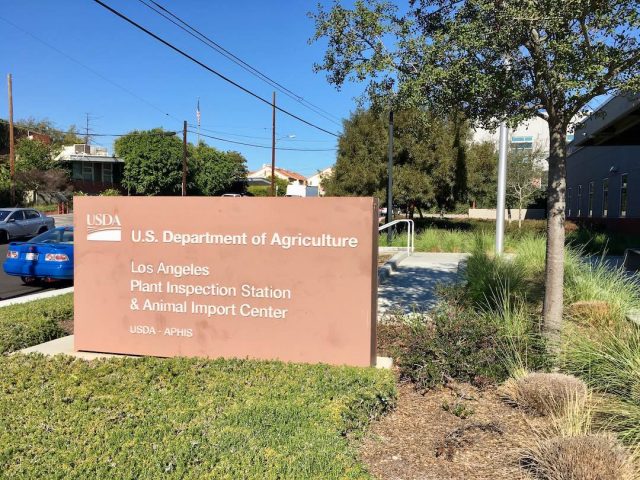
(Note that the situation for endorsements changed in 2022, with endorsements now done either electronically by the Veterinary Export Health Certification System (VEHCS) or by shipping the paperwork through a courier company. Australia accepts the digital signature and digital endorsement. )
This is the stressful point, at which if all the vet preparations haven’t been properly completed, including on the correct dates, it could be rejected. I saw this happen to one other woman also taking her dog to Australia during my visit. The office advised her to speak directly to the Australian government department to see if she could get an exemption, but I don’t now what was the result.
My first slight hiccup at the Veterinary Service office was that I didn’t bring along a print-out of Schnitzel’s full import permit, just the health certificate part. This was easily fixed, by emailing the staff member the permit to print out.
However, as well as the full permit and health certificate, plus his rabies titre test lab report and laboratory reports for the other three tests, the office also required another lab report. This was because one of the tests was sent to a separate lab to be done, although the result was still included in the main lab report.
What ensued was 3 hours of backwards and forth trying to get the extra lab report, speaking on the phone to my vet and then the vet speaking to the various labs. My vet said that normally this wasn’t required, so either someone was being extra strict or they had changed the requirement.
A few tears were shed, but finally, we received the extra lab report by email and everything was endorsed. The hardest part is they wouldn’t review everything else and say if everything else was in order, until the extra lab report was received!
For this reason, I recommend getting your certificate endorsed straight after your final vet visit, not the day of your flight, in case any issues come up that take longer to sort out.
9. Buying a Crate
Because we were travelling around in a car and didn’t want a large crate taking up most of our car boot, we left buying a crate until late, although we investigated the options earlier and had already selected which crate to buy.
We went with the basic Grreat Choice kennels sold by Petsmart. Fancier options are available, but we didn’t know whether we would use it more than once. Also, the price listed on the website was cheaper than the price in store, so we got them to price-match it.
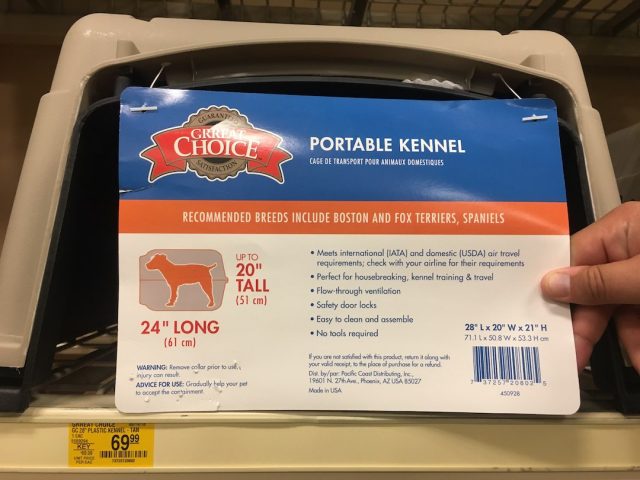
To determine the size crate required for your pet, the calculations are listed on this International Air Transport Association (IATA) page (click on “Do you have a suitable container for your pet?” and “Guidance for Dimensions of Container”). This ensures that your pet can “stand, sit and turn around in a natural matter inside a crate”.
It’s also ideal to test your dog inside the crate before going ahead with the purchase. Additional requirements might be specified by your airline, but Qantas just stated on my phone call it should have metal bolts, which mine did.
In addition to the crate, we bought a puppy pee pad and duct-taped it inside, then added my dog’s old bed. Any bedding is tossed on arrival in Australia, so don’t use something you want to keep. We also added a water bowl that was fillable via a funnel without opening the door, also bought at Petsmart. Some airlines might required food containers and food attached to the outside of the crate.
Qantas said it didn’t require this, but we taped some to the top of his crate, in case of a delay. I also taped his name to the front of the kennel, just above the door. If you’ve got any special instructions, tape them to the outside of the kennel.
After picking up and constructing the crate, I did have a minor panic that it wasn’t as large as I had remembered, and that we had the smaller size and would be rejected by Qantas Freight. (The label at the front was missing when we purchased it.) We ended up going back to the store, but it was all good in the end!
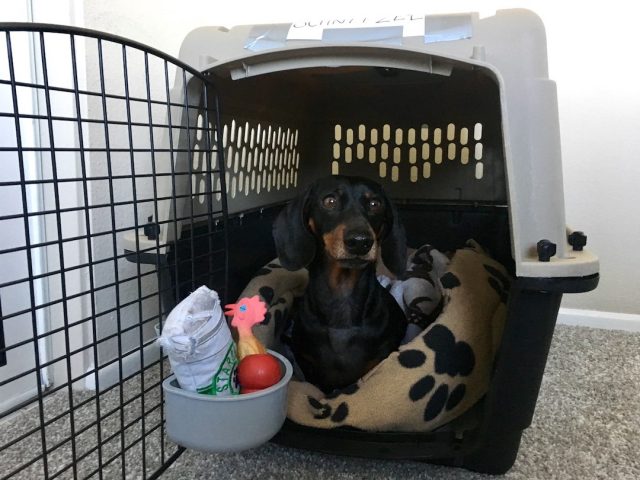
10. Dropping My Dog Off
The very final step was to drop Schnitzel off at the freight terminal. We had been given a set time to drop him off, about 6 hours before his actual departure. A few hours before this we gave him his final meal and drink, then encouraged him to do his business on the grass near the freight terminal when we arrived.
Inside the terminal it was bustling with various drop-offs. The drop-off took longer than we expected, but it was quite relaxed. There was no measuring that the animal and the crate met the guidelines, and no issues were brought up.
It was only at this point we paid for his flight, along with filling in the required freight paperwork. His paperwork was attached in a zip-lock bag to the outside of the kennel (provided by Qantas), along with some live animal stickers.
It was then time to say our final goodbyes. At least we knew Schnitzel would be with experienced hands. He wasn’t the only pet being dropped off that evening for the Qantas flight to Melbourne; in fact we asked and were told up to 20 animals would be on the flight! However, it was extra tough saying goodbye knowing we wouldn’t even see him on the other end, that he was going straight into quarantine.
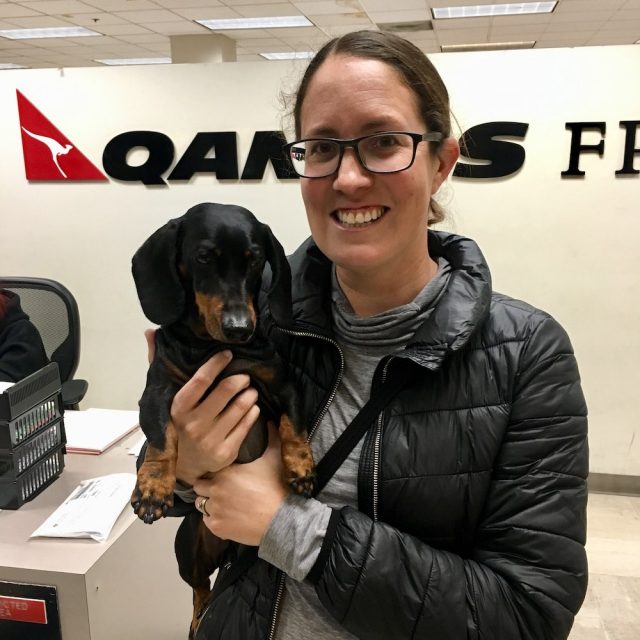
My Dog’s Stay in Quarantine in Australia
At the time of my dog’s return to Australia, all dogs and cats arriving in Australia had to spend a minimum of 10 days in quarantine. However, since March 2023, pets travelling from some countries (including the United States), now have to spend a minimum quarantine period of 30 days, unless an identity verification step has been completed.
If there is an issue with your pet, they may also require a longer stay, but amongst people I’ve spoken to over the years, their pet has only stayed 10 days.
This means that you can’t meet your pet on arrival at the airport in Australia, they’re instead whisked off to the quarantine facility in Mickleham, near Melbourne Airport. It was partially due to this that we flew directly to Sydney, instead of on the same flight as Schnitzel to Melbourne.
Our flight back to Sydney left the same night, scheduled for 5 minutes after Schnitzel’s flight. We tried to catch sight of Schnitzel being loaded onto his plane, but our gates were too far apart. On our arrival in Australia, we then checked the status of his flight, and saw that it soon safely landed. And later that afternoon I received an automated email from quarantine to say he had arrived.
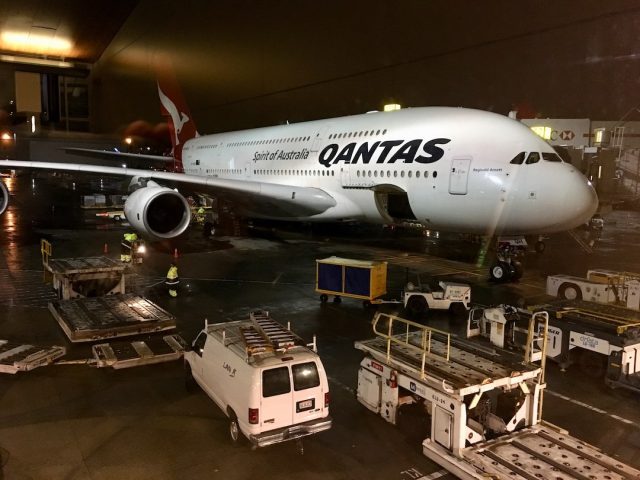
As I was naturally a bit worried about how he coped with the long flight to Melbourne, I tried to call quarantine (and gave up due to the long hold time), but sent an email. I received a reply two days later saying that he arrived safe and well, was eating and toileting, plus his arrival weight. It was a relief after the long flight and not seeing him on the other end!
He was due to be released from quarantine on a Monday, and then immediately fly up to Sydney as organised by Jetpets. I hadn’t yet heard anything further by Thursday, so I called up again. I knew I had to schedule a release appointment in the quarantine system once he was given the okay to be released.
On the phone (after a 20 minute hold) I was told that everything was in order (plus he was eating, toileting, and friendly!) Just the vets hadn’t done their final checks, as it was a busy time of year. That would occur Friday or Saturday morning.
Just after lunch on Friday I received the confirmation that Schnitzel would be released on Monday, and scheduled his release appointment for Jetpets to pick him up.
With quarantine, if there are issues with your pet, that’s when you’ll hear more from them. Otherwise, don’t expect more than a couple of automated emails about the status of your dog and when you need to schedule the release appointment (which occurs between 10am and 12pm on the release day).
On the Monday, I received an email from quarantine to say he had been released, but I’d already received an email from the Jetpets driver who took him to Melbourne airport, complete with a photo. It was great to get a photo of him, although it was only a few short hours later that we met him at the Jetpets facility in Sydney. He was very excited to be re-united with us!!
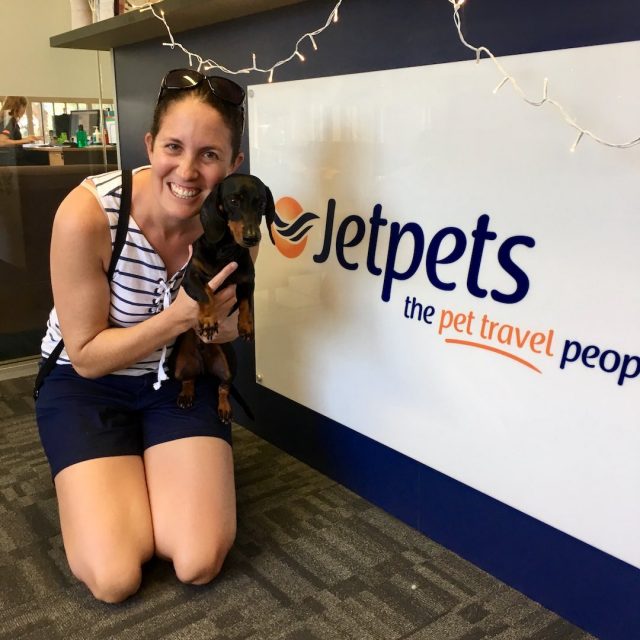
During Schnitzel’s stay in quarantine, he noticeably lost some weight, which was confirmed once we weighed him. However, he had been getting slightly overweight, and it was probably just due to the amount of food he was fed being slightly less than what we gave him. He was possibly a little quieter for a day, but still our usual excitable and lovable Schnitzel, back together with us!
Find out more about quarantine for your dog in Australia
Cost of Bringing A Dog to Australia
Finally, here’s a breakdown of all the costs for bringing our dog back to Australia (following the above steps), organising everything myself.
Import permit: $480
Quarantine application: $29
Three vet visits: $1537
Standard quarantine fee: $1581
USDA APHIS VS endorsement: $204
Crate and water bowl: $82
Flight cost from LA to Melbourne: $1314
Flight from Melbourne to Sydney including pick-up from quarantine (with Jetpets): $235
Additional charge from quarantine (listed as “recovery of airline handling charge’): $97
Total cost: $5559 AUD (approx. $4000 USD)
Naturally, the cost of bringing a dog to Australia will vary depending on the size of your dog, the location you’re flying from and the exact steps that you need to perform. But I hope this gives you an indication of what it can cost.
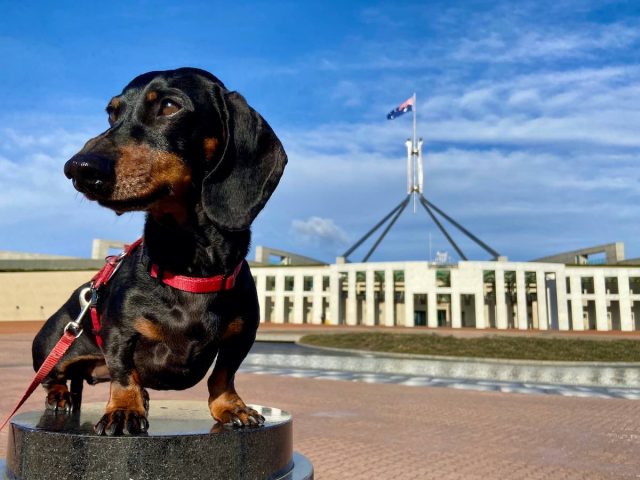
Many of these costs are constant (mainly the government ones, except they occasionally go up). When comparing our costs to those quoted by other people online, the vet visits in other countries were often lower (for instance, someone exporting their pet from Canada listed a total of $833 AUD for the 3 vet visits, nearly 50% less than our costs).
Going through an animal transport company typically adds about $1000 AUD more to the total cost, although it is difficult to compare as often the costs are not broken down.
Additionally, in recent years, many of the flight costs have increased, including domestic flights in Australia for pets. Government charges have also increased – the above charges applied in 2018.
Find out more about the latest cost of bringing a dog to Australia
Was It Worth Organising Myself?
So, was it worth organising everything by myself to bring my dog to Australia? While I don’t know exactly how much it would have cost if I organised everything through an animal transport company (instead of just the final flight to Sydney), I know it would have cost significantly more. I likely saved around a thousand dollars, perhaps more.
In return, I did stress about it a few times during the journey. (Particularly when we had the issues at the USDA APHIS Veterinary Service office!) And there were some steps that weren’t clear at first, that professionals who deal with pet travel every day would have been more familiar with.
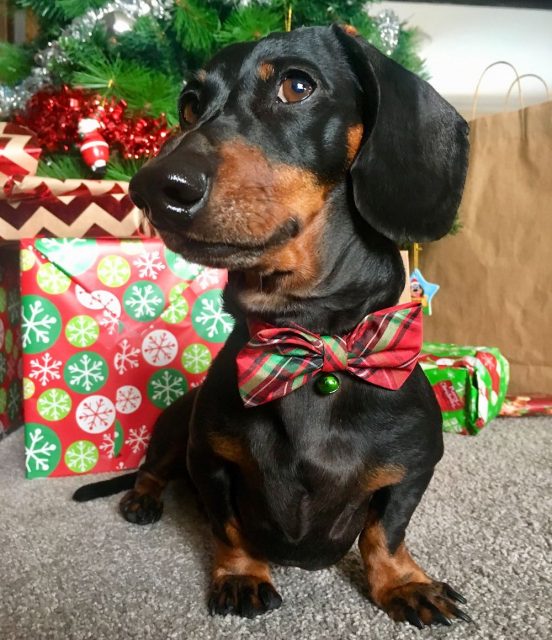
Overall I’m happy with the saving that I made, in return for my extra work. However, that’s partially as nothing went wrong in the end.
If something hadn’t been prepared properly, or there was an issue with the flight, or a number of other things, I may have had to turn to an animal transport company in the end, and it would have been a lot easier if I was dealing with one all along. So, keep that in mind!
Read more about whether you should use a pet transport company
You May Also Like
- How Much Does It Cost to Bring a Dog to Australia?
- Tips for Importing a Dog to Australia
- All You Need to Know About Dog Quarantine in Australia
- How to Take Your Dog Overseas from Australia
About the Author
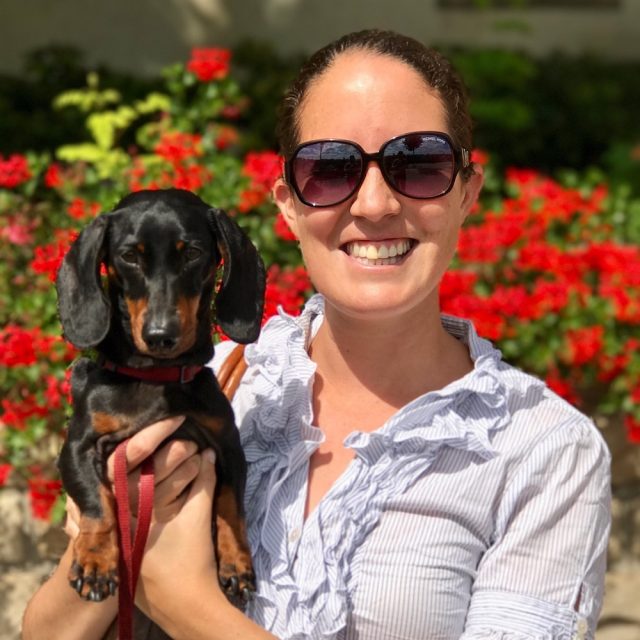
Shandos Cleaver is the founder of Travelnuity: Dog-Friendly Travel. She has travelled extensively with her Miniature Dachshund, Schnitzel, including to 33 countries across Europe, every state and territory of Australia except Tasmania, and 10 of the United States. She’s passionate about providing inspiration and information to others wanting to travel with their dogs, whether close to home or internationally.
Inspired? Pin this to your Pinterest board!
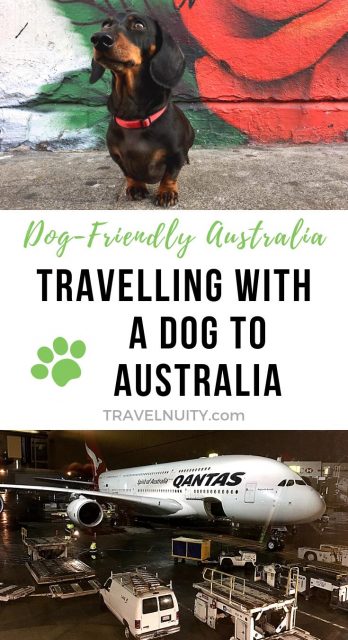

I am so happy that you and Schnitzel are both back safe in Australia. It sounds like a headache getting all of that paperwork sorted – and so much is time dependent as well.
I am hoping it is much easier for me to stay in Europe & the EU with my pup. Trains will be our best friend. But I am considering bringing the pup with me to the US after a year in Europe. I don’t think a trip to Australia is in our future but I really enjoyed reading this whole article. Thank you for sharing it with us and enjoy your Christmas!
Thanks Molly! Australia makes it really tough. Travelling around the EU with your pup is a piece of cake, and also flying to the USA. Merry Christmas and a Happy New Year!
This could not have been posted at a better time.
I am flying to Kuwait from the US in February and from the US to Melbourne in July. And just started my pup’s paperwork. I made my own list(s) of things to do before arriving in Melbourne, some will have to be done here in the US and some in Kuwait. Thankfully two of the requirements to take her to Kuwait (3 of them) are also required for her to be taken to Australia, and will be valid to use when I travel. Also, I think the vet is much cheaper in Kuwait than in the U.S. so that will take a few hundred dollars off. Good on you for loving this poochy so much, they deserve it.
Glad to help Mallory’s Mom! The US vets (at least in the city) seemed more expensive than the vets in Europe, so I’m sure you could save some money that way. Enjoy your time in Kuwait!
Thank you so much for this guide! We’re in the process of moving two cats and a dog to Australia from the USA, and as you encountered, there’s hardly anyone out there who posted much information about their experience with the process (especially doing it yourself, like us.)
Just wanted to say thanks, it helps a lot to hear someone else’s success story.
Thanks so much and all the best with the move! This is precisely the reason I shared all my notes 🙂
Just thought I’d share an update — thanks largely to your guide, our pets successfully arrived in Australia! There were a few anxious moments but they arrived safe, sound, and stressed. Thank you again for your thoughtful guide!!
Thank you so much for this post. I’ve been doing my own research on how to NOT use a transport company to move my cat to Australia in January and this post really put me at ease.
Thanks Kelsey! I will admit that it can be stressful doing it all yourself, but if you have a good vet, all should be fine.
Thank you so much for this post! We’re planning to bring our two dogs from California to Melbourne and have been really panicking because the requirements are so complicated. It’s good to know it can be done without hiring a transport company and how much the costs would be.
You mentioned that the quarantine facility tosses the bedding upon arrival. Do you get to keep the travel crate?
Glad to help, it is quite a daunting experience! Luckily, while the bedding is tossed, the travel crate is kept. When you pick up your dogs, they are back in their crate.
I really appreciate your information that every pet going into Australia needs to stay in quarantine for at least ten days. With that in mind, I think that I should find a quality vet clinic to take my Berner to after quarantine. That way, I can know if she will need any diet or exercise changes in this hotter climate.
Thanks Sarah! I’m not sure if any diet changes will be needed, but definitely keep in mind the hotter temperatures over the summer, and be careful during the middle of the day.
Hi Shandos, this post is great. We are currently planning to take our dog from the UK to Australia without using an export agent. However, I have recently spoken to both Quantas and Singapore Airlines who say they won’t accept our booking unless it’s through an animal export agent. Is this something you encountered?
Sophie
When I last checked, Qantas only allowed direct bookings for single hop flights or for flights with the same code (same plane) without a transfer. We booked directly last December (LA to Melbourne) and I’ve known some people who have booked directly between the UK and Australia. However, perhaps they have changed and reduced the cases where they allow direct bookings. And I haven’t come across any other airline that allows direct bookings for flights to Australia. I’d recommend speaker to a pet transport company, such as Jetpets.
Hi Sophie, I am also trying to move our dog from UK to Australia, and getting very mixed results about whether I can do this myself, or whether it now has to be done through and agency. Did you get any further finding out if this is the case?
Would love to find out, too! Best of luck
Hello, this is currently the issue I’m running into as well. I’m importing my dog from TX to Sydney (via Melbourne of course) and all the airlines I’ve contacted told me they only accept bookings from pet transporters.
The majority of airlines I’ve looked into require using a pet transport company, but I haven’t looked into all airlines. At the time I made my booking, Qantas accepted direct bookings from LA to Melbourne, but I’ve heard reports this isn’t always allowed at all airports. They don’t provide further details of this on their website.
Hi. Not a pleasant question but what happens if the dog needs the toilet on the flight?! Do they soil their cage and do quarantine clear it up?? I’m worried about our dog!
You should put absorbent bedding in the crate – we added a couple of puppy pads to the bottom, then used an old blanket on top. Although I know our dog (and probably many other dogs) don’t like to go in “odd places”, so will hold on during the flight.
On arrival in Australia, all bedding gets disposed of due to biosecurity regulations. I’m sure the actual crates also get washed to comply with the regulations. When we were reunited with our dog, the crate was lined with a recent newspaper instead.
Thank you so much for posting this guide! We are thinking of returning to Sydney in the next year and this really helped breakdown the complicated government guidelines! Our dog is also a daschund 🙂 x
They sure are daunting when you firstly look at them! Glad I could help 🙂
Thank you so much! I am mid-way through the process and came across your article – gives me a much need confidence boost!
Thanks for your kind words and good luck with everything!
Excellent piece and bravo for doing it. I’m toying with taking my Jack Russell to Oz from the UK for a long trip. This has been really helpful. Thank you.
Corky – Great to hear, thanks!
Thank you for this helpful post, we are contemplating the same process and it’s great to hear that you managed it successfully. Could you please tell me if the prices you quoted are in Australian dollars or US dollars. Thank you
All the prices are in AUD, if necessary they were converted from USD to AUD using the exchange rate from last year when we did this.
Is it harder with bigger dogs? We want to bring out 70 lb mixed breed.
The only difference is that the crate for the flight is bigger and will cost more. I believe the quarantine fees are the same.
Hi Shanos! Words cannot describe how appreciative I am about this post! I am currently in the process of moving my Cavalier to Melbourne, and it has been quite the headache. Moving my dog, Ali, with a professional company would cost between USD$5600 – $9000 according to the estimates I received, which is out of my price range. This post has been my reference point and main hope for knowing that it is possible to move her without a company. I did have a quick question about vaccinations. Vaccines such as canine influenza, are required, but I can’t find anywhere that says how Australia verifies that the dog received these vaccinations. If I provide a copy of her vet records has the date of vaccination and the dog influenza vaccine sticker on it, will this be considered sufficient proof?
Kirsten – Thanks so much and sorry about the delay in replying. (I’ve been on a busy trip recently.) In terms of records, the final vet that you visit fills in the health certificate for Australia, then this is stamped by the government authorities and needs to travel with your dog to Australia. If you have the vaccine done at a different vet, show them a copy of the vet records with the sticker on it. They may also call up and speak to the vet. (I believe my vet in LA did this with the vet in NYC.) Best of luck!
I am in the process of moving back to Australia after living in SF for 14 years. We just got a puppy he is now 5 months and I did not realise that i have to wait 180 days for the rabies test. That sux!! Anyway, do you know if we can start all the process and tests etc during the 180 days. Or do I have start after the 180 days. BTW the Quarantine fee has gone up to$2000! Thanks so much for your amazing post!!!
That’s not the best timing! (And I’m not surprised the fee has gone up!) Yes, you can start the process and tests before the 180 days is up, that’s just the count down before your dog can arrive back in Australia. When you fill in the import permit with proposed dates, they will checked this over.
Hi! OMG this is so helpful. I’m a student and I have two pets, a whippet (dog) and Maine coon (Cat). I love them so much, very long story and im very attached. Im going to Melbourne for grad school and I want to bring them with me. The reality is this process is as you know, incredibly “unaffordable” for me as a student, but I still havnt and do not plan on giving up! I am trying to save every penny I have for this trip. Reading this means a lot to me, I can see that there are people who are going through the same process.
Glad I could help! I wouldn’t want to leave them behind, too.
Thanks so much for sharing your experience! I am in Canada and starting the process to do it myself. For Canada I just found out Air Canada provides the service to fly to Melbourne. Here’s their email reply:
”
Hello:
We do have service for pets to Australia (depending when you are going) We would have to go to Melbourne to Australia’s quarantine facility.
The process is that we make a booking for you (if you have time check out our website Aircanadacargo.ca for a check list and kennel requirements for your pet).
You would give us the permit number for your pet to Australia, and we send the info to Australia and wait for the ok to forward your pet. The ok to forward your pet comes with confirmation with the quarantine facility that you have paid any fees.
We need to know the breed of your pet, wgt, and size of the kennel and when you are looking at going. Subject to seasonal embargos, we can only make bookings up to 28 before deparature.
On the website there is a picture to find out what is the best size kennel for your pet.”
Hope this helps others 🙂
Thanks Channel so much for sharing this information! I’ve heard other recommendations for Air Canada, and will definitely share this with anyone who asks. Plus it’s great that you’ve shared the details here.
Hi,
quick question, you might know the answer to but if i am importing two dogs from LA to Melborune can the dogs travel in the same crate?
They are two small chihuahuas.
Thank you for the article really helped!
I would check with the airline, this policy often differs between different airlines.
Thank you for this comprehensive post. WOW! It’s an excellent resource!
I’m moving from Amsterdam to Australia later in 2020. Having read this, I can see why the pet relocation companies charge as much as they do.
ELF – That’s certainly true! The majority of the fees charged by the pet transport companies are simply the fees you’d have to pay to the airline, plus the other costs. And it’s a lot of stress if you organise it yourself.
Hello Shandos, My name is Kelly and I currently live in south korea. I’m trying to take my dogs from south korea to australia. But I have one questions if you could help me. There’s no DIRECT flight from korea to melbourne. It will be like korea- malasia- melbourne.. something like that. And I was told that, If it lands in another country, then this can be a problem. I’ve noticed that there’s no direct flight from LA to Australia.. so… my question is ,, did you have to provide additional documents or etc for this reason?? Thank you for your assistance and I’m so glad you and schnitzel are together .. Thank you ^^
Kelly – Luckily there’s direct flights from LA to Australia, so this made our experience easier. Looking at the Australian government website (https://www.agriculture.gov.au/cats-dogs/step-by-step-guides/category-3-step-by-step-guide-for-dogs, Step 8), they say “the dog may transit (touch down but stay on the same plane) or tranship (change aircraft) in any country en route to Australia”, with a few extra notes about things to check about transhipping, which is what you’ll likely be doing. Malaysia (plus Singapore is another likely option) are both approved countries, which makes things easier. This shouldn’t require any extra paperwork, as long as transhipping is allowed by the intermediate country/airport. I’ve also noticed that Asiana flies once per week to Melbourne, although I don’t know if they fly animals. I’m surprised at the lack of flights – I’m in Sydney and there’s plenty of flights from here directly to Seoul, but the government here doesn’t allow dogs to fly via Sydney to Melbourne for quarantine.
This is the best post I have read about relocating a dog from US to Australia. Thank you for taking the time. We are still tossing up whether to use a pet relocation company. It’s a tricky one as our family may need to leave before our puppy (who will still be in the 180 day period). 🙁 Has anyone had experience with a pet relocation company? Just trying to weigh up the options. Thank you!
Zhoe – I’ve covered this topic in a recent post: http://www.travelnuity.com/pet-transport-company/. If it’s likely you will need to leave earlier, I recommend using a pet relocation company, at least for managing the actual flight, as it’s a lot of responsibility to leave with anyone else.
Hi Shandos,
This post it’s absolutely great! I’m actually doing the same thing, I’m importing 3 miniature dachshunds from Spain to Sydney, and after several month looking for information and places FINALLY I could find everything that I need for the importation but my only question that you may know. After the dog arrives to Melbourne airport, who take him/them to the Quarantine? It’s something we need to do? Or the same airline staff will do it for us?
Regards
Elena
Thanks Elena! I’m pretty certain it’s quarantine staff who come and pick up the dogs (I didn’t actually meet them). When booking quarantine you specify which flight your dog will be on. There’s no chance to see your dog before they go straight into quarantine, part of the reason we flew straight home to Sydney.
I don’t know how I stumbled upon your post but I AM SO HAPPY that I did. My husband and I are moving to Melbourne with our Australian Shepherd from Michigan, USA. We have been looking through pet transport companies because we were told we wouldn’t be able to book the international flight ourselves. All of the quotes we have found have been between $7,000 and $9,000 USD for both the domestic flight and international! It’s insane. I am in the process of finding out if Quantas has changed their requirements for booking but if they still allow us to book his flight ourselves it would AMAZING. He is much bigger than yours but I am still hoping for a MUCH lower cost than what is being quoted. There is such limited information online about the actual booking of flights so thank you, THANK YOU, for sharing this and giving us hope!
Megan – I’m glad you came across my post and I hope this can help you save a lot of money. It’s hard to know whether this is still possible at the moment, with lots of flights being cancelled or disrupted, including USA to Australia. Best of luck with organising the move!
Thank you so much for this. Any idea what the in-flight experience and in-quarantine experiences are like for the dogs? Was your dog tranquilized during flight? Get exercise and friendly care at the quarantine facility? Any insight into their experience i’d really appreciate. My dog has never flown before or stayed at a kennel, so I just worry what he’ll go through. Any thoughts?
Kate – I’ve got a post about what quarantine is like here: http://www.travelnuity.com/dog-quarantine-australia/. There’s exercise facilities and I’d guess the staff are animal lovers and caring, but it’s hard to get updates just about your dog. With flights, dogs should rarely be tranquillised or sedated, it’s quite dangerous for them. Your dog will handle the flight best if they’re used to being crated (get your crate and get your dog familiarised with it ahead of time).
Hi Megan. We have also been quoted $9000 to ship from the US. Were you able to book the flight directly?
No actually, because of COVID we had to cancel our plans for August 2020. We are now trying to re-plan for February 2021. Qantas is still the only one that allows you to book without an agent and since Qantas is barely running at this moment we had to choose to go through an agent. We emailed about 15 different companies and went with the one that seemed to care the most and cheapest pricing. Still will cost us about that unfortunately. So far he is tentatively booked for quarantine so we will see if flights work out this time around.
Thanks Shandos, we want to get our springer spaniel from Barcelona, Spain back to Sydney.. you have helped us a LOT.. thanks..!!
Glad to hear that! Fingers crossed that the situation surrounding flights to Australia and particularly Melbourne improves by the time you return.
Hi! Firstly your dog must be the luckiest and mostly travelled dog in the world, and is absolutely gorgeous! I hope he got Qantas frequesnt flyer points for all that trouble and cost!
20 years ago we were moved by my husbands Company to Chicago and then to New York, and we took our cat with us, I think Jetpets had just started up then, and they were fantastic. I was never sure of the cost of it then, because it was part of the relocation package. Lucky lived a long and happy life, but has since passed on.
Now I’m back in Australia, I have aother rescue cat in NYC called Billy Joel, he’s approximately 14 now, so I left him with a trusted friend, but I miss him so much, and want to bring him back to Australia, apparently age isn’t a problem if he’s healthy (how can any cat be healthy living indoors in Manhattan)!
Jetpets are no longer importing pets to Melbourne, so I came across your website – very brave to tackle that by yourself, and move at the same time! Also so informative.
I guess I am asking, although you moved Schnitzel yourself, are you aware of any other reputable pet transport companies? I’m a bit concerned because he’s has so many changes already, with me disappearing, and now this – I’m hoping he can get all his pre-vet work done in NYC, (do you think that is possible-I would have lost my sh** if that happened to me at the airport with the paperwork – not very helpful are they!), however then he still has to fly to LAX then to Melbourne. I dont want to put his health in jeopardy just because I miss him (as crushing as it is)! I cannot believe half of the cost is quarantine (though glad its only 10 days), and how’s the cost of the flight for one small pet!!!! I mean Billy Joel had better be getting the latest movies and unlimited champagne down there at that price!
Do you have any other advice for me? I’m already in Australia, so there’s no question I’ll have to pay the extra for a company like Jetpets. I do overthink things, like its a 15 hour flight – what if he doesnt have water if it splashes out if there is tubulance etc, he’s already quite old as it is, we dont need renal failure.
Thanks in advance for any words of wisdom!!
Katie
Katie – Thanks so much for sharing! At the moment, I would continue to hold off transporting a pet to Australia. Due to the situation with limited flights, flights for animals are far more expensive at the moment. There’s also the risk of flights being cancelled, and messing up the careful preparation required for pets. However, hopefully this changes in 2021. (I’m not sure how long you’ve been in Australia now??)
With Jetpets, they might again be transporting pets to Melbourne, due to international flights restarting to Melbourne. For a period, the government was allowing pets arriving in Australia to fly into other cities, but this was just an interim measure. Additionally, Qantas is not currently allowed direct bookings and isn’t flying at all internationally (or just to and from NZ?)
I’ve previously only used Jetpets, both when we flew overseas initially and then to fly Schnitzel from Melbourne to Sydney after his stay in quarantine. Another company I know others have used is Dogtainers. There’s also US based companies, that an Australia company would need to work with for a dog coming from overseas to Australia.
In regards to water, some animals can be trained to use a sipper bottle, the type you usually see with rabbits and guinea pigs. I didn’t worry about this, as I know my dog has a tendency to not drink much water when we go out for the day and during similar circumstances. As your cat is older, I would definitely check with a vet whether they feel your cat is up to the journey, some airlines will require an extra signature for older pets over the age of 12.
Hope this helps!
Hey! I was just wondering where are the dogs in the flight? Is there someone to reassure them. My dog is really anxious and i’m really stressed about his reaction…Thanks for your awesome article! It’ll help me a lot!
Kim – Unfortunately, animals are flown in a special hold compartment. It’s kept at a similar temperature and pressure to the main cabin, with the lights dimmed, but isn’t accessible from the main cabin. I’d speak to your vet about whether they recommend anxiety treatments for your dog, although sedation is not usually recommended these days, due to increased health risks.
Thank you very much for sharing this! Just wanted to ask since you chose US as your export company – how did you prove that Schnitzel stayed there for at least 6 months prior to departure? Based on the date of import to the US and the health certificate issued by the vet in LA?
There was no requirement at the time to spend 6 months in the one country; has this been introduced now? I know it’s a requirement for NZ
Hi,
Thank you so much for this web page. I just got quoted 11.5k U.S to handle my border collie back to Australia. Big FAT no on that! So here I go….I know you asked expats about approved vets, but is there another list somewhere online that I could use. Im currently in Atlanta Georgia.
Sorry, I don’t have another list. I recommend speaking to a few vets – either one should be approved or a vet might be able to recommend another approved vet.
Hi Shandos,
Thanks for sharing your experience. I have an 8 year old toy poodle who has been with me since he was a pup. I live in Turkey and have plans to move to Australia. But I can’t bear the thought of leaving him behind. Besides the exorbitant costs, I have two main concerns about transporting him from a non-approved country (i.e. Turkey). Do you have any tips on that? Also, did you do anything to prepare Schnitzel for the long trip? My dog has a heart condition and he has never been in a crate (the flight would be upwards of 20 hours). Thanks.
Definitely get your poodle used to a crate, even if it won’t be the actual flight crate, as soon as possible. My Schnitzel was crate trained as a puppy, and it made it so much easier, that he thinks of crates as his “safe” space. I’d also speak to your vet about whether your dog’s heart condition is a risk for flying, and whether they recommend anything. Generally sedatives are advised against, but some vets recommend calming treatments. (We didn’t use any with Schnitzel.)
With regards to transporting from a non-approved country, I don’t have experience myself with this, but most people I know have used a kennel/vet to home their dog while the steps take place, unless they themselves temporarily move. Unfortunately, it also adds to the cost of transporting to Australia.
Hope this helps!
Hi Shandos
We currently live in Singapore where our dog (6month old golden irish, Marlo) lives with us. We are planning to leave Singapore to travel around Europe for 6months in July and we want to take Marlo with us. He has not had any rabies vaccine yet and from what i understand he can get into the EU w/o any titer test? However im more concerned about how we deal with the entry into Australia. Is it better to organsie the rabies test and titer in SIngapore beofre we leave? Also does that mean he needs a booster in Europe beofre flying to Australia?
Hi Mark! Your dog will require a rabies vaccine but not the rabies titre test to fly to the EU – Singapore is exempt. I assume you’re also aware of the EU health certificate? However, yes, it would be best to get the rabies titre test done now to fly your down to Australia, as it needs to be done at least 180 days (not not more than 2 years) before your dog flies to Australia. Most rabies vaccines last either 3 years or 1 year (probably more do 3 years) and Australia recognizes the 3 year vaccines, so you shouldn’t need a new vaccine before flying to Australia.
Hi Shandos
Thanks so much for your excellent post! Do you have any fresh information post Covid on transport from US to Australia? It is so hard to find information. Are carriers to Oz accepting pet transport at all independently of pet relocation companies?
We took our German Shorthair Pointer from US to Italy and then back from Germany to US and it cost only 200 Euro in excess baggage plus another 120 Euro for vet fees. It was stressful and a lot of organising but all was OK. It is going to be a shock importing into Australia 🙁
Someone recently told me (I think they left a comment on another blog post) that Qantas have restarted taking direct bookings on the flights from LA to Melbourne. This hasn’t been updated on their website, and I haven’t spoken to Qantas myself, but it’s worthwhile calling up Qantas Freight in LA to discuss (https://freight.qantas.com/freight-terminals/americas/los-angeles.html).
This post was exactly what I was looking for in my research today. There’s so few resources online that discuss this process so in depth! I’m currently trying to arrange to move my cat with me to the UK from Australia, and was unsure what sort of costs I would be looking at to do it myself versus with a company like JetPets – I’ve been quoted 5k AUD, and based on you having paid the same even if it was for a dog going the other way, I reckon for me it’ll just be semantics and the difference won’t be too dramatic (especially considering there’s an enormous tax on arrival into the UK for pets!) so I’ve decided to book with a company instead. I really appreciate your post, thank you for being so helpful as to share your experience!
Thanks Lori for your kind words. While it is usually cheaper if you organise things yourself (if it’s possible with the airline), it’s not usually that much cheaper. Most of the cost is just the high flight costs (which are even higher since Covid) and other government costs, which can be difficult to calculate in advance.
Hi, I’d love to talk to you about this. I am a bit stuck, also bringing my dog via the US from Europe. I’m currently in the US, because my dog has her rabies titre test (RNAT) and endorsement from Sweden, however, on the health certificate that the USDA has to approve, it needs them to approve the RNAT, and I am not sure they will do that if the RNAT was performed in another country. But it sounds like your RNAT was also from another country (ie. Australia) so maybe it’s not a problem??
It’s best to speak to the USDA to find out. My situation was probably a bit different as the RNAT was done in Australia and we were going back to Australia.
Hi Shandos,
I’m so glad I found your atricle! I feel like there aren’t enough articles, videos, or guides for the process to bring a dog to Australia.
The explanations on the page of the Department of Agriculture aren’t very clear, my local vet ( I live in France ) isn’t aware of the steps to follow, I was desperate until I found this! Thanks for taking the time to write.
I have a question though. I read that your dog already had his rabies test from Australia. This rabies titre test thing sounds so important in the whole process! Mine is in French though… I’ll need to get it translate. Is it the thing you send to Australia for the import permit ect?
I could translate it myself since I am fluent in both languages, to save some money…
My fur baby has a few special needs regarding food, I guess I can write a letter to the PEQ people and get my vet to make an official paper too.
With gratitude
Mimi
Mimi – Yes, the rabies test lab report needs to be included with the import permit application, along with the declaration from the official government veterinarian. It states on the government website that the lab reports needs to be in English on the testing laboratory’s letterhead – can you request the laboratory to provide this?
Definitely write to the PEQ people to request special food for your dog. I did this as I wanted my dog to be fed twice per day, not once pet day. It’s probably best to find a food available in Australia to request. (Look at the main pet store websites like Petbarn.com.au, Petstock.com.au.)
Wishing you all the best – it’s a complicated process!
Hi Shandos!
I currently live in Las Vegas, USA but I am considering relocating back to my home country of Australia. I have 3 small dogs and they are my world. I am going through a divorce, so there is nothing keeping me here in the USA any longer and I really want to go back home to be with my family. The thought of my 3 small dogs (Arnie, Ziggy and Tina) going underneath in the cargo is the most daunting part of all of this, to be honest. The quarantine (although I have heard its like prison) is not the most horrible part for me, its the flight itself. I wish Australia would let us bring the dogs in the cabin with us, I would be happy to pay for an entire row of seats to have them in a carrier in the cabin with me, and then put them in quarantine upon arrival. Oh well, its not the case! Anyway, I found your blog/article SO helpful and informative, so I just wanted to say a huge thank you. Knowing you did it with a small dog is very reassuring for me. Thanks and fingers crossed everything goes smoothly for me!
Thanks Natalie and hope all goes well with your flight! Most people I’ve spoken to have said their dogs handle the flights to and from Australia better than expected – I think the worst part is just not knowing. Maybe one day we’ll be able to fly them in the cabin, but it’s unlikely anytime soon.
Thanks for the helpful info!
Has anyone had an experience getting their pet from Canada to Australia recently? Air Canada no longer fly direct from Vancouver to Melbourne so it’s proving a challenge. There is an American Airlines option through LA with a considerable layover, or through Auckland with Air NZ, all with different flight numbers. Not so keen on the pup having a layover in a crate, but I don’t see another way.
Thanks,
Shannon
Shannon – I haven’t heard of anyone who has done this recently. I’ve also just checked with Qantas, but they are only flying to Sydney at the moment, not Melbourne.
Hi Shandos, where can we find the information to find an approved vet in the US?
Also I am thinking to move back to Australia this year, date not decided yet unfortunately due to work schedule. But I was thinking to get rabies shot and titer test done first to save time in case we decide to move earlier rather than later. Does the rabies shot needs to be done by the approved vet also?
Thank you in advance!
The USDA recommends using this process to find an approved vet: https://vsapps.aphis.usda.gov/vsps/public/VetSearch.do. They list some vets, but also recommend just asking your local vet, and if they aren’t approved, they should know a vet that is approved.
It’s definitely a good move to get the rabies shot and titer test done early, due to the long waiting time after the test. The rabies shot doesn’t need to be done by an approved vet, but the titre test does.
Thanks for sharing your story! So happy you guys made it safe.
We’re in the process of getting our dog from Mexico to LA to Perth. We are using a pet company. Thanks for the info on the vet. May I ask where you stayed for the time in LA .. it’s so costly 😳🫣😱. We are trying to find the best solution for our stay for 5 weeks.
We didn’t stay in LA the whole time, we went on a road trip in between vet appointments. However, I know car rental prices are now so much more expensive. When in LA, we stayed at some nice Airbnbs in a private room (shared house).
Thank you for this post, I have been following it for a year now as we are due to ship our dog to Melbourne from LA. Unfortunately I am finding out that his Leishmania infantum test is out of compliance by 1 day 🙁
We had done the test with a view of the 45 day window until export. The airline changed the date of the flight by one day. Now we are just outside of the 45 days window. Should have built some slack in my planning.
Has anyone else faced such difficulties? the only option seems to be to redo the test, re-book quarantine , re-book flight (if there are spaces)
i’d be interested to hear if there is anyway of getting an exemption or if anyone else has faced the same conundrum.
Luckily this didn’t happen to us, so I’m not sure if an exemption is possible. I recommend phoning or emailing the Australian Department using the details on their website asap.
Hello,
I am so grateful to come across your post.
I have a dachshund too and planning to move back to Melbourne from Canada.
I was having a hard time finding a pet relocation company so I decided to just do it myself.
Unfortunately I found out Australia has now changed the rule and the titer test is no longer valid for 2 years. Luckily I still have his export permit to confirm he is from Australia, meaning he only needs to quarantine for 10 days. But his tirer test is coming up one year so I have to do another titer test before this expires, otherwise I need to wait 180 days again.
I am extremely anxious about transporting him myself, like you said it’s the flight. I am going to contact Qantas to see whether they can book directly again but if not, does it mean I need to use a travel company? And how do you find out the best route to transport as there isn’t a direct flight from Toronto to Melbourne either.
Thank you,
Sarina
Sarina – It’s unfortunate that they’re changing the rules and the titre test is no longer valid for 2 years, but it’s lucky you have the export permit to prove his identification. I’ve heard that most overseas countries don’t yet have the new system set up, which would mean a long 30 days in quarantine.
If Qantas don’t let you book directly, it’ll be necessary to use a pet transport company. I’ve heard some mixed reports, but I suspect you’ll need a pet transport company. They’ll be able to advise you on the best routes, which will probably involve a domestic flight to Vancouver. Then I’m pretty sure Qantas fly directly to Melbourne, perhaps also Air Canada.
Wishing you all the best!
Hello,
I’m so glad I came across your blog!
I was wondering how long you allowed for in LA to do all the tests/vet visits etc?
And does the animal have to have been in the exporting country for a certain amount of time, before they can get on a flight?
We’re currently in Canada, but thinking we could spend time in LA before returning to Aus. But does the whole process have to start in USA or can we start in Canada (microchip/titer test)?
Thanks
All up, we were in the USA for about 2 months, before flying our dog to Australia, including two or three stays in LA over six weeks, with road trips in between. This year, the rules have slightly changed – your pet needs to have been in “Approved countries” for the last 180 days. Canada is also approved, and you can start preparations there, if the US authorities are okay with this.
This is what the Aus. government website says: “You will need to check if the official government veterinarian of the approved country of export is prepared to attest that your pet has not resided in a non-approved country for the 180 day period prior to export to Australia, and that they will accept any preparations completed in another approved country for the purpose of endorsing the final veterinary health certificate.”
Hi Shandos,
I live in France and I’m taking my dog (Tongo) to Australia this Autumn 2024 to live there. I was planning on going to England for a 2 month trip this summer before coming back to France to finish the export procedures.
I noticed that the BICON website indicates that : “The dog must be continuously resident for at least 180 days immediately before export, or since birth, in approved countries or Australia.”
Do you know if this means that Tongo can’t leave France at all or seeing as England is also an approved country then it’s ok? I noticed that there’s an “S” on the end of approved countries… so I’m hoping that he can go from France to the UK and back without any problems for his export to Australia.
Please let me know if you have any more information regarding this.
Thank you
Rosie & Tongo
This is a relatively new requirement that didn’t apply when I last flew back to Australia with Schnitzel, but I believe it’s fine that you’re in multiple approved countries, including England as well. It’s best that all preparations are done in France, though – there used to be a requirement that the country of export must approve of any preparations done in another country, but I can no longer see this mention.
Hi Shandos,
Thank you so much for writting this post! I’m midway through my journey of bringing my dog to Australia from Canada – I had to hire a company since I’m not out there with her for these past couple months and wanted to make sure everything was done properly. I just have a couple of questions for you if you don’t mind.
Is there a reason for the test for Leishmania and Lepto to only be done on the second appointment and 20+ days after the first? I’m asking because I’m boooking mine for 14 days after the 1st appointment to give enough time for the tests to come back
I’ve booked my pup’s last appointment for Wednesday, April 3rd – she leaves Canada for LA on the 7th, pauses for a bit then leaves for Melbourne on the 8th. The 3rd is exactly 5 days from the 8th, do you think that’s risky if they move her flight?
My company has advised that it shouldn’t matter since she leaves Canada on the 7th, therefore that’s her departure date and she’s only transitting through the US but it would be reassuring to hear it from someone who’s been through it personally.
This is so anxiety inducing, you’re a trooper for doing it on you own!
Cheers,
Fernanda
Hi Fernanda! The reason we did the test for leishmania and lepto at the 2nd appointment rather than the 1st is it needs to be within 45 days before export, and our first appointment was 47 days before export. Ideally it would have been done earlier than we had it done, as the test results took longer than expected. With the 3rd appointment, I would ideally have it a little closer to the departure date from Canada (maybe one day later?), in case of a delay. Although it is nerve-wracking having it at the last minute! It sounds correct that it’s the departure date from Canada that’s important – that’s where her paperwork is all checked and signed off. Wishing you all the best with the move – it’s a tough one!